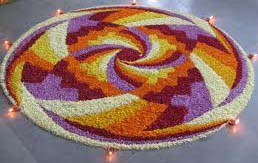| Onam |
 |
Onam, the principal festival of Kerala, is celebrated against a setting of lush green vegetation. This picturesque harvest festival brings ten days of colour feasting, boat races, song and dance to the state.
According to legend, the state's most colourful festival, Onam celebrates the golden age of King Mahabali, the mythical ruler of Kerala. The festival is to welcome the spirit of King Mahabali, and to assure him that his people are happy and wish him well. The myth goes like this:
|
 |
The Devas or Gods were worried over the wise and good rule of Mahabali, the Asura king, thinking that he might become too powerful. They sought the help of Vishnu (the preserver in the Hindu trinity) to curb Mahabali's power. Vishnu, in the form of a dwarf called Vamana, approached him and had been offered a boon by the king. The Vamana asked for three paces of land and the king agreed to it. |
Soon the dwarf began to expand and with the first step, he covered the sky, blotting out the stars, and with the second, he straddled the nether world. Realising that the Vamana's third step will destroy the earth, Mahabali offered his head as the last step. The Gods were glad, but since Mahabali was so attached to his kingdom and the subjects and was very much loved by the people, he was allowed to return once a year. Onam (Thiruonam) is considered to be the day when King Mahabali comes from exile to visit his beloved people.
The festivity begin ten days before Thiruonam, by putting floral decorations (Pookkalam) on every home. At Trichur(Thrissur), caparisoned elephants take part in a spectacular procession. A magnificent display of fireworks marks the end of the festivities here. At Cheruthuruthy, appreciative crowds gather on the green, where the Kathakali dancers, resplendent in their brilliant costumes, re-enact the well-loved stories of the epic heroes and virtuous women. Pulikali, also known as Kaduvakali is a common sight during Onam season. Performers painted like tigers in bright yellow, red and black, dance to the beats of instruments like udukku and thakil.
The Vallamkali (boat race) is one of the main attractions of Onam, and is best seen at Aranmulai and Kottayam. About a hundred oarsmen row huge and graceful odee (boats). Oars dip and flash to the rhythm of drums and cymbals in each boat. The songs are generally typical in character and concern people well known in Malabar. Above each boat gleam scarlet silk umbrellas: their number denotes the affluence of the family owning the boat. Gold coins and tassels hang from the umbrellas.
In the evening girls perform the Kaikottikkali (Thiruvathirakkali ) in the open, dancing around the traditional brass lamp.
|
|
|
| Religions |
In India, religion is a way of life. It is an integral part of the entire Indian tradition. For the majority of Indians, religion permeates every aspect of life, from common-place daily chores to education and politics. Secular India is home to Hinduism, Islam, Christianity, Buddhism, Jainism, Sikhism and other innumerable religious traditions. Hinduism is the dominant faith, practised by over 80% of the population. Besides Hindus, Muslims are the most prominent religious group and are an integral part of Indian society. In fact India has the second largest population of Muslims in the world after Indonesia.
|
| Read more about Indian Religions |
|
|
